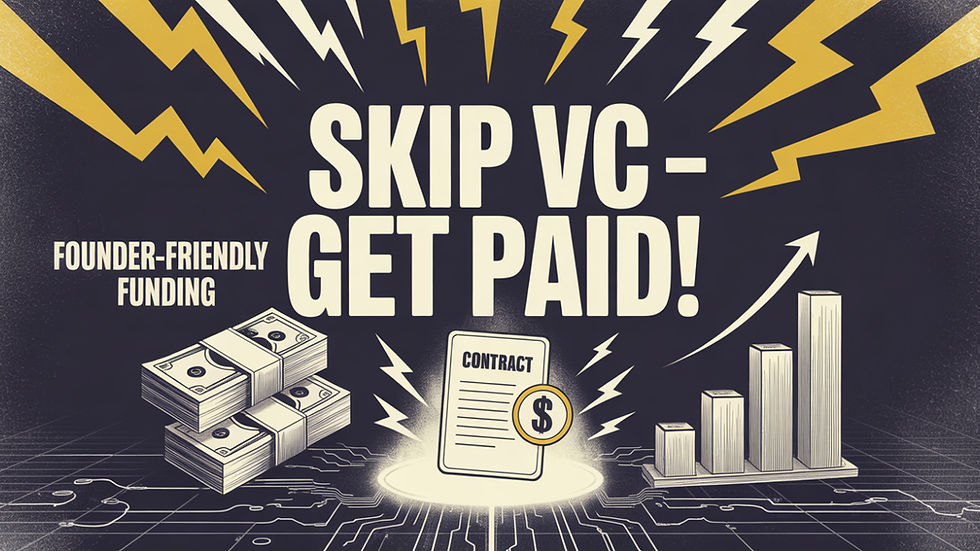Venture Capital for Acquisition Financing: How Startups Can Buy Their Way Into Growth
- Jason Feimster
- Sep 24
- 4 min read
Dreaming bigger than your balance sheet? Venture capital for acquisition financing gives founders the firepower to seize opportunities, outpace competitors, and rewrite their company’s future. This isn’t just funding—it’s the catalyst for bold moves, faster growth, and market domination.

Introduction: The Moment That Changes Everything
Evernony founder eventually faces a defining moment. You’ve built traction, survived sleepless nights, and pushed your startup into the market—but growth feels like a slow burn. Then, suddenly, the opportunity appears: acquire a competitor, merge with a strategic partner, or buy technology that could catapult your business forward.
The problem? You don’t have the cash reserves to write that kind of check. Traditional banks will demand collateral you can’t provide, and waiting to grow organically risks losing the deal altogether.
This is where venture capital for acquisition financing enters the picture. Unlike debt, venture capital isn’t just money—it’s conviction. When the right investor believes in your acquisition thesis, they back it with capital, expertise, and networks powerful enough to change your company’s trajectory overnight.
What Is Venture Capital for Acquisition Financing?
At its core, venture capital for acquisition financing is the practice of using equity investment from venture capitalists (VCs) to fund a business acquisition. Instead of borrowing, you exchange a portion of ownership for the capital required to close the deal.
Unlike banks or traditional lenders, VCs don’t rely on collateral or credit scores. They bet on growth potential, market fit, and your ability to turn an acquisition into a revenue multiplier. For startups, this can be a game-changer: access to capital when it matters most, without crippling interest payments.
Why Startups Use Venture Capital for Acquisition Financing
Speed of Market Domination
Markets move fast. If a competitor has the customer base, distribution network, or technology you need, acquiring them might be faster and cheaper than building from scratch. According to industry data, 70% of acquisitions are pursued to eliminate competition or expand market share—and VCs are often enthusiastic about funding moves that secure dominance.
Strategic Expansion Without Losing Leadership
With careful deal structuring, founders can retain decision-making authority while leveraging VC funds. The trick lies in negotiating terms that balance equity dilution with strategic gains. For many founders, the ability to lead a larger, stronger company outweighs the ownership percentage they give up.
More Than Money: Networks and Expertise
When you bring a venture capitalist into an acquisition, you’re not just buying capital—you’re accessing mentorship, boardroom influence, and industry introductions. These intangible assets often prove more valuable than the check itself.
The Challenges and Risks You Must Acknowledge
Venture capital for acquisition financing isn’t free fuel—it’s power with obligations. Every founder must weigh the risks:
Loss of Autonomy: VCs will expect influence over major strategic decisions.
Pressure for Rapid ROI: Venture funds operate on strict timelines, usually targeting exits within 5–7 years. Your acquisition strategy must align with that clock.
Cultural Clashes: Merging two organizations is complex; mismatched teams or conflicting visions can erode value rather than create it.
The emotional truth? Venture capital can accelerate your growth—but it also accelerates accountability.
Step-by-Step Roadmap to Secure Venture Capital for Acquisition Financing
Step 1 – Build a Compelling Acquisition Thesis
Investors don’t fund “nice-to-have” ideas. They fund transformative opportunities. Your acquisition thesis should prove that buying this company dramatically accelerates growth, strengthens defensibility, or increases valuation.
Step 2 – Target the Right Venture Capital Firms
Not all VCs back acquisitions. Focus on firms with a track record of funding buyouts, roll-ups, or M&A-driven growth. Platforms like Crunchbase or PitchBook can help you research investors who specialize in acquisition strategies.
Step 3 – Build Your Financial Model Like a Fortress
Your projections must show how the acquisition increases revenue, margins, and exit potential. Scenario analysis—best case, base case, worst case—builds investor confidence.
👉 See also: VCs Are Just Payday Lenders in Patagonia Vests
Step 4 – Negotiate Smart: Equity vs. Control
Founders who walk into negotiations unprepared often give away more than they realize. Understand how much equity you’re willing to exchange, and consider protective terms like super-voting shares or earn-outs.
Step 5 – Post-Acquisition Integration Planning
This is where many startups stumble. Investors want proof you can merge operations, teams, and cultures without destroying momentum. Present a clear integration playbook.
ROI Potential of VC-Funded Acquisitions
To see the upside, imagine this scenario:
Before Acquisition: A SaaS startup with $4M annual revenue, growing 25% year-over-year.
After Acquisition: By acquiring a competitor with $6M revenue and 2,000 additional customers, combined revenue jumps to $10M. With cross-selling opportunities, growth accelerates to 45% year-over-year.
Valuation multiples rise accordingly. A company once worth $20M could now command $50M+ in a funding round or acquisition. This is the power of venture-backed acquisitions: compressing years of organic growth into a single decisive move.
Alternatives to Venture Capital for Acquisition Financing
Venture capital isn’t the only path. Depending on your risk tolerance, you might consider:
Debt Financing: Less dilution, but requires repayment and collateral.
Private Equity: Similar to VC, but often involves more control concessions.
Seller Financing: The seller allows deferred payments, reducing upfront capital needs.
Each alternative has trade-offs, but venture capital remains the most founder-friendly option when speed and scale are critical.
FAQs on Venture Capital for Acquisition Financing
Can venture capital be used directly for acquisitions?
Yes, though not all firms support this. Target VCs with an explicit M&A investment thesis.
How much equity do VCs typically take?
Ranges widely, but expect 15–30% ownership in exchange for major funding rounds tied to acquisitions.
Do VCs prefer growth through acquisition or organic scaling?
It depends. Many VCs encourage acquisitions when they accelerate growth and defensibility faster than organic methods.
Is this only for tech startups?
No. While tech leads the way, venture-backed acquisitions happen across industries—biotech, fintech, and even consumer brands.
Conclusion: The Courage to Pursue the Deal
The founders who reshape industries are the ones who act boldly when opportunity knocks.
Venture capital for acquisition financing is not the easy path—it’s the high-stakes route that demands courage, vision, and relentless execution.
If you’ve identified the acquisition that could rewrite your future, don’t let limited capital hold you back. Investors are out there, waiting to bet on founders who see not just the present, but the potential.
It’s not just about buying a company. It’s about buying time, market share, and a future that compounds faster than your competitors can react.
👉 Ready to deepen your strategy? 💣 When VCs Ghost You, This Bot Doesn’t: Why VC Backup Plan GPT Might Save Your Business (and Your Sanity)






Comments